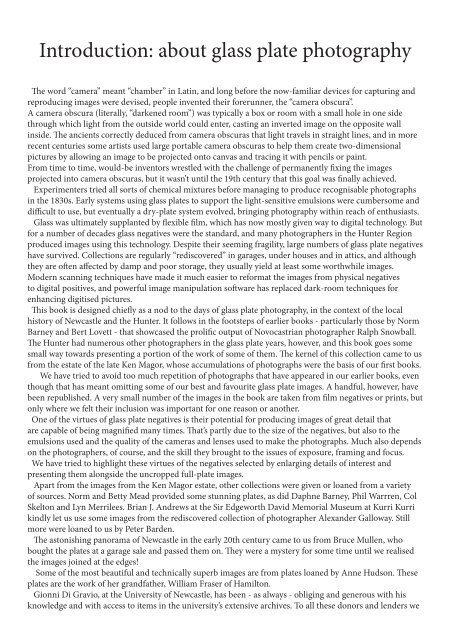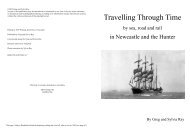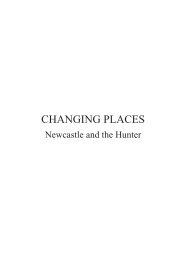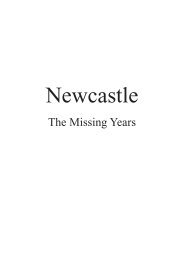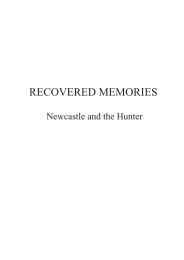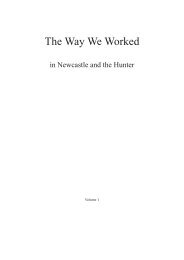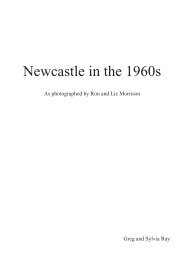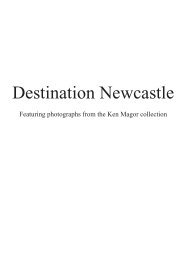Pages from Newcastle on Glass
You also want an ePaper? Increase the reach of your titles
YUMPU automatically turns print PDFs into web optimized ePapers that Google loves.
Introducti<strong>on</strong>: about glass plate photography<br />
The word “camera” meant “chamber” in Latin, and l<strong>on</strong>g before the now-familiar devices for capturing and<br />
reproducing images were devised, people invented their forerunner, the “camera obscura”.<br />
A camera obscura (literally, “darkened room”) was typically a box or room with a small hole in <strong>on</strong>e side<br />
through which light <str<strong>on</strong>g>from</str<strong>on</strong>g> the outside world could enter, casting an inverted image <strong>on</strong> the opposite wall<br />
inside. The ancients correctly deduced <str<strong>on</strong>g>from</str<strong>on</strong>g> camera obscuras that light travels in straight lines, and in more<br />
recent centuries some artists used large portable camera obscuras to help them create two-dimensi<strong>on</strong>al<br />
pictures by allowing an image to be projected <strong>on</strong>to canvas and tracing it with pencils or paint.<br />
From time to time, would-be inventors wrestled with the challenge of permanently fixing the images<br />
projected into camera obscuras, but it wasn’t until the 19th century that this goal was finally achieved.<br />
Experimenters tried all sorts of chemical mixtures before managing to produce recognisable photographs<br />
in the 1830s. Early systems using glass plates to support the light-sensitive emulsi<strong>on</strong>s were cumbersome and<br />
difficult to use, but eventually a dry-plate system evolved, bringing photography within reach of enthusiasts.<br />
<strong>Glass</strong> was ultimately supplanted by flexible film, which has now mostly given way to digital technology. But<br />
for a number of decades glass negatives were the standard, and many photographers in the Hunter Regi<strong>on</strong><br />
produced images using this technology. Despite their seeming fragility, large numbers of glass plate negatives<br />
have survived. Collecti<strong>on</strong>s are regularly “rediscovered” in garages, under houses and in attics, and although<br />
they are often affected by damp and poor storage, they usually yield at least some worthwhile images.<br />
Modern scanning techniques have made it much easier to reformat the images <str<strong>on</strong>g>from</str<strong>on</strong>g> physical negatives<br />
to digital positives, and powerful image manipulati<strong>on</strong> software has replaced dark-room techniques for<br />
enhancing digitised pictures.<br />
This book is designed chiefly as a nod to the days of glass plate photography, in the c<strong>on</strong>text of the local<br />
history of <str<strong>on</strong>g>Newcastle</str<strong>on</strong>g> and the Hunter. It follows in the footsteps of earlier books - particularly those by Norm<br />
Barney and Bert Lovett - that showcased the prolific output of Novocastrian photographer Ralph Snowball.<br />
The Hunter had numerous other photographers in the glass plate years, however, and this book goes some<br />
small way towards presenting a porti<strong>on</strong> of the work of some of them. The kernel of this collecti<strong>on</strong> came to us<br />
<str<strong>on</strong>g>from</str<strong>on</strong>g> the estate of the late Ken Magor, whose accumulati<strong>on</strong>s of photographs were the basis of our first books.<br />
We have tried to avoid too much repetiti<strong>on</strong> of photographs that have appeared in our earlier books, even<br />
though that has meant omitting some of our best and favourite glass plate images. A handful, however, have<br />
been republished. A very small number of the images in the book are taken <str<strong>on</strong>g>from</str<strong>on</strong>g> film negatives or prints, but<br />
<strong>on</strong>ly where we felt their inclusi<strong>on</strong> was important for <strong>on</strong>e reas<strong>on</strong> or another.<br />
One of the virtues of glass plate negatives is their potential for producing images of great detail that<br />
are capable of being magnified many times. That’s partly due to the size of the negatives, but also to the<br />
emulsi<strong>on</strong>s used and the quality of the cameras and lenses used to make the photographs. Much also depends<br />
<strong>on</strong> the photographers, of course, and the skill they brought to the issues of exposure, framing and focus.<br />
We have tried to highlight these virtues of the negatives selected by enlarging details of interest and<br />
presenting them al<strong>on</strong>gside the uncropped full-plate images.<br />
Apart <str<strong>on</strong>g>from</str<strong>on</strong>g> the images <str<strong>on</strong>g>from</str<strong>on</strong>g> the Ken Magor estate, other collecti<strong>on</strong>s were given or loaned <str<strong>on</strong>g>from</str<strong>on</strong>g> a variety<br />
of sources. Norm and Betty Mead provided some stunning plates, as did Daphne Barney, Phil Warrren, Col<br />
Skelt<strong>on</strong> and Lyn Merrilees. Brian J. Andrews at the Sir Edgeworth David Memorial Museum at Kurri Kurri<br />
kindly let us use some images <str<strong>on</strong>g>from</str<strong>on</strong>g> the rediscovered collecti<strong>on</strong> of photographer Alexander Galloway. Still<br />
more were loaned to us by Peter Barden.<br />
The ast<strong>on</strong>ishing panorama of <str<strong>on</strong>g>Newcastle</str<strong>on</strong>g> in the early 20th century came to us <str<strong>on</strong>g>from</str<strong>on</strong>g> Bruce Mullen, who<br />
bought the plates at a garage sale and passed them <strong>on</strong>. They were a mystery for some time until we realised<br />
the images joined at the edges!<br />
Some of the most beautiful and technically superb images are <str<strong>on</strong>g>from</str<strong>on</strong>g> plates loaned by Anne Huds<strong>on</strong>. These<br />
plates are the work of her grandfather, William Fraser of Hamilt<strong>on</strong>.<br />
Gi<strong>on</strong>ni Di Gravio, at the University of <str<strong>on</strong>g>Newcastle</str<strong>on</strong>g>, has been - as always - obliging and generous with his<br />
knowledge and with access to items in the university’s extensive archives. To all these d<strong>on</strong>ors and lenders we


